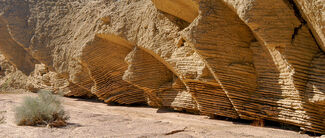Nature Watch: "Rhythmite"
Last updated 4/29/2021 at 1:44pm
Most visitors who first look out upon the Carrizo Badlands often describe the area as a wasteland.
In reality this area south of Fish Creek is a rich earth laboratory of marine fossils, petrified wood and fascinating geological formations, all visible and waiting to be studied.
For the casual visitor it's not about seeing these interesting bits of ancient earth history but more about understanding them.
It's complex and jumbled, the result of immense geological forces, weather, earthquakes and the long hands of time that have shaped this current landscape.
Erosion and the naked mudhills have put the history of the earth on full display here, including a fascinating geological formation known as rhythmite, formed four to five million years ago when today's badlands were hidden beneath a shallow sea that inundated the eastern edge of Anza-Borrego.
As the name suggests, there is a distinct rhythm to this formation, characterized by a thick deposit of fine sand in uniform layers.
What forces in nature are so precise and cyclical to create such uniform layers?
The exact origin of rhythmite is still debated by geologists, but one thing is sure. A rhythmic action such as tidal flows, seasonal silt deposits from streams or flood waters, or some other cyclical process over a long period of time created these consistent layers.
The deposits forming rhythmite are composed of turbidites, defined as sedimentary deposits of material that has moved down steep slopes into a body of water.
Other examples of this are the sediments that have washed down and then accumulate in deep sea canyons.
The rhythmite formations visible in part of Fish Creek are often tilted or bent, a testimony to the strong geological forces that created this environment.
Keep an eye out for these formations on your next visit to the Carrizo Badlands.
Contact Ernie @ Packtrain.com or follow http://ernieoutdoors.blogspot.com.




